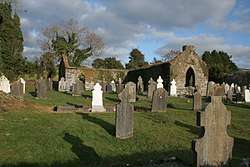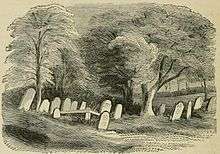Macreddin
Macreddin (Irish: Maigh Chríodáin, meaning "plain of Cridan";[1][2] formerly also Moycreedin;[3] formerly officially Carysfort,[4] also Cariesfort[3]), is a hamlet in County Wicklow,[5] in the southern foothills of the Wicklow Mountains, 4 km north of Aughrim on the back road to Greenan.[6] The historical borough is in the townland of Macreddin West in the civil parish of Ballykine, barony of Ballinacor South.[2] It also gives its name to the adjacent townland of Macreddin East.[2][7]
Macreddin Maigh Chríodáin | |
|---|---|
Hamlet | |
 The ruined Catholic church and Upper Macreddin Cemetery | |
 Macreddin Location in Ireland | |
| Coordinates: 52.8842°N 6.3309°W | |
| Country | Ireland |
| Province | Leinster |
| County | County Wicklow |
| Elevation | 160 m (520 ft) |
| Irish Grid Reference | T12348278 |
Wicklow County Council's 2010 development plan recognises the site as an "area of archaeological potential and significance" as "site of one of the few 17th century Plantation Towns established in Leinster".[8] The pre-1800 parliamentary borough of Carysfort and the title Earl of Carysfort derive from Carysfort.
History
The name Macreddin is believed to come from the Irish Magh Chrídáin "plain of Cridan".[1] In 1875, John O'Hanlon identified him as a Celtic Christian saint "Criotan, Credan, Credanus, or Cridanus", son of Iladon, who was also venerated at nearby Aghavannagh, and in Cornwall.[7] Price says he was more likely a local chieftain at the time Saint Kevin proselytized the area.[1] Macreddin was granted to the monastery of St Saviour, Glendalough in the 12th century.[1] When the Diocese of Glendalough was merged with the Archdiocese of Dublin, Macreddin was transferred to the Priory of All Hallows in Dublin.[1] On the Dissolution of the Monasteries under Henry VIII, it was transferred to Dublin Corporation.[9]
County Wicklow was established in 1606 and the Dublin Castle administration sought to contain the threat to English planters from the Gaelic O'Toole and O'Byrne clans in the mountains.[4][9] A fort was built at Macreddin while Henry Cary, 1st Viscount Falkland was Lord Deputy of Ireland in 1625-28, and named "Cary's fort" in his honour.[1][9][10] Samuel Lewis records that the garrison was withdrawn to Dublin in the 1641 Rebellion and the site was captured from the English by the O'Byrnes.[9] No visible trace of the fort remains; the site is reputed to be in "Castle Field".[11]
In 1628, Carysfort was incorporated as a borough under a royal charter from Charles I.[4][12][13] The corporation was to have the same powers as at Jamestown, County Leitrim.[3] The 1835 report of the Commissioners into Municipal Corporations in Ireland stated the charter did not appear "ever to have been acted on for any corporate purpose, except that of returning Members to Parliament before the Union".[3] The charter granted the 13 members of the corporation "600 acres of arable land and pasture, and 276 acres of bog, mountain, wood, and underwood" in free burgage, and three smaller parcels of land in socage to each fund a specific purpose: first the garrison, second a Protestant curate and glebe, and third a free school.[3] A 1688 charter of James II restated these grants; but by 1835 all lands except the school's had been alienated.[3]
The elevation of Carysfort was too high and settlers soon moved south down the valley to Aughrim.[4] In the eighteenth century there was still a fairground at the crossroads, with "riotous" two-day fairs held at Whitsun and All Saints.[14][15] Michael Dwyer stayed in Macreddin when repairing to the Wicklow Mountains after the 1798 Rising.[16] The 1835 commissioners' report described Carysfort as "a small village, containing a few houses of the humblest class", and concluded, "There is but a thinly-scattered population in the neighbourhood, and neither trade or commerce of any kind in the village, and there seems to be no occasion whatever for reviving the corporation."[3]
Religion

In the Church of Ireland, Carysfort was a royal chapelry, originally with a thatched chapel by the school in Sheeana.[17][18] It was within the perpetual curacy of Ballinaclash erected in 1832.[17][18] A chapel of ease at Gallows Lane in Macreddin opened in 1869 to replace that at Sheeana; it was deconsecrated in 1991.[18] The Catholic church was dedicated to Saint Brigid and Lewis in 1837 reported it as the parish church of Rathdrum.[9] In 1864 it was rededicated to Laurence O'Toole;[7] it is now in ruins. Upper Macreddin Cemetery is in the churchyard, while the larger Lower Macreddin Cemetery is further down the valley.
Royal School
Under the 1628 charter, Carysfort Royal School was established with a schoolhouse in the neighbouring townland of Sheeana More, to be funded from revenue of lands there.[12][19][20] The revenue was not well used and the school was of poor quality;[9] an 1810 work said "about 50 Boys attend in summer, but not above a dozen in winter".[21] To resolve such abuses there and at other endowed schools, an 1813 Act of Parliament transferred management of the lands to Commissioners for Educational Endowments in Ireland.[9][17][19][22] £500 was spent on a new building and in 1833 the school had 110 students funded from 361 acres.[3] Whereas the other Royal Schools established by the Stuart kings were grammar schools, the Carysfort school was "a small, neglected, and inefficient primary school"[23] and in 1887 the Commissioners recommended using its endowment to fund schools in more convenient locations in Aughrim and Rathdrum.[24] In 1925 the management was transferred to the Department of Education of the new Irish Free State,[25] where it is still vested.[26]
Parliamentary borough
Carysfort was a borough constituency sending two MPs to the Irish House of Commons.[9] It was a pocket borough of the Proby family, who took the title Baron Carysfort.[9] It was disfranchised under the Act of Union 1800, and John Joshua Proby, 1st Earl of Carysfort received the standard £15,000 compensation for the loss of its patronage.[3][9][10][17]
Amenities
Southwest of the historical centre of the hamlet is a tourist complex comprising the Brooklodge Hotel, Wells Spa, "Macreddin Village" and golf club.[27][28]
References
- Price, Liam (1980) [1945]. The place-names of co. Wicklow. 1 - barony of Ballinacor North. The Dublin institute for advanced studies. pp. 10, 62, 69–70. ISBN 978-0-901282-34-7.
- logainm.ie: Macreddin East Macreddin West
- "Borough of Cariesfort". Appendix to the First Report; Part I South Eastern and Part of the North Eastern Circuit. House of Commons papers Vol XXXVIII Reports from Commissioners. 8. HMSO. 1835. pp. 457–8. Retrieved 29 January 2012.
- Cullen, Louis M. (1981). The emergence of modern Ireland, 1600-1900. Batsford Academic and Educational. pp. 61, 66, 73. ISBN 978-0-7134-2747-9. Cullen, Louis M. (January 1979). Irish towns and villages. Eason. pp. 32–3.
- "Map 2.11" (PDF). County Development Plan. Wicklow County Council. Archived from the original (PDF) on 31 January 2014. Retrieved 30 January 2012.
- "R753–L97538 junction signpost". Google Streetview. Retrieved 30 January 2012.
- O'Hanlon, John (1875). "11th day of May, Article I". Lives of the Irish Saints with special festivals, and the commemorations of holy persons compiled from calendars, martyrologies, and various sources relating to the ancient church history of Ireland. 5. Dublin: J. Duffy. pp. 211–213.
- "Volume 2 - Built heritage" (PDF). Wicklow Draft County Development Plan 2010 - 2016. p. 22. Retrieved 30 January 2012.
- Lewis, Samuel. "CARYSFORT, MOYCREDDIN, or MOYCREDYNE". A TOPOGRAPHICAL DICTIONARY OF IRELAND. Retrieved 30 January 2012.
- Society for the Diffusion of Useful Knowledge (1843). "Wicklow". Penny cyclopaedia. XXVII. C. Knight. p. 359. Retrieved 29 January 2012.
- "Wicklow 2006:2150 Macreddin Brook Golf Club". Excavations.ie. 2006. Retrieved 30 January 2012.
- "Letters Patent to Corporate Bodies in Ireland, conveying Lands for Education; Orders by Commissioners of Education in Ireland for Free Students in Royal Colleges of Armagh, Dungannon, Enniskillen, Raphoe and Cavan, 1840-50; Correspondence on Royal College". C 475. House of Commons. 1851. pp. 5–19. Retrieved 29 January 2012.
- British Borough Charters 1307-1660. CUP Archive. 1923. p. 199.
- O'Donnell, Ruán (1998). The rebellion in Wicklow, 1798. Irish Academic Press. p. 26. ISBN 978-0-7165-2659-9.
- Hansbrow, Rev. G. (1835). An improved topographical and historical Hibernian gazetteer: describing the various boroughs, baronies, buildings, &c., scientifically arranged, with an appendix of ancient names. To which is added, an introduction to the ancient and modern history of Ireland. R.M. Tims. p. 316. Retrieved 29 January 2012.
- Dickson, Charles (1944). The life of Michael Dwyer: with some account of his companions. Browne and Nolan limited. pp. 138, 185, 222.
- "Carysfort". The Parliamentary gazetteer of Ireland: adapted to the new poor-law, franchise, municipal and ecclesiastical arrangements, and compiled with a special reference to the lines of railroad and canal communication, as existing in 1814-45. I. A. Fullarton and co. 1846. p. 340.
- "History of the Church". Aughrim, Ballinatone, Castelmacadam group of Church of Ireland parishes. Retrieved 30 January 2012.
- Quane, Michael (1961). "Carysfort Royal School, Co. Wicklow". J. Roy. Soc. Antiq. Ireland. 91 (2): 193–217. JSTOR 25509433.
- Endowed Schools, Ireland, Commission (1858). "Carysfort Royal School Estate". Report. Alex Thom and Sons. p. 30. Retrieved 30 January 2012.CS1 maint: multiple names: authors list (link)
- Carlisle, Nicholas (1810). A topographical dictionary of Ireland: exhibiting the names of the several cities, towns, parishes, and villages ... Collected from the most authentic documents, and arranged in alphabetical order. Being a continuation of the topography of the United Kingdom of Great Britain and Ireland. Printed for W. Miller, by W. Savage. p. 163. Retrieved 30 January 2012.
- 53 George III c.107 s.xi
- Educational Endowments (Ireland) Commissioners: annual report, 1886-87, minutes of evidence and appendices. p. xx. Retrieved 30 January 2012.
- Educational Endowments (Ireland) Commissioners: annual report, 1886-87, minutes of evidence and appendices. pp. xv–xvi, 304–5. Retrieved 30 January 2012.
- S.I. No. 22/1925 — The Commissioners of Education in Ireland (Transfer of Functions) Order, 1925 Schedule 3
- Dáil debates Vol. 393 No. 1 p.233 c.186
- "The Village". Macreddin Golf Club. Retrieved 29 January 2012.
- "Zoning for further Development of the Integrated Tourism/Leisure Recreation Complex at Brook Lodge" (PDF). County Development Plan. Wicklow County Council. pp. Map 27. Archived from the original (PDF) on 31 January 2014. Retrieved 30 January 2012.
External links
- Macreddin, visitwicklow.ie (Wicklow County Tourism)
| Wikimedia Commons has media related to Macreddin. |